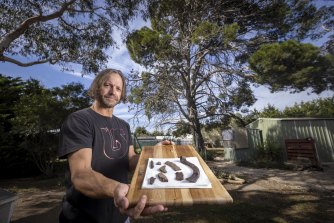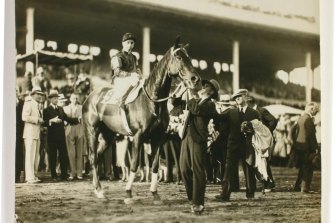A proposed subdivision at the property where champion racehorse Phar Lap was hidden after an attempted shooting on Derby Day in 1930 will face additional heritage demands after neighbours objected to the removal of a tree thought to shelter the graves of racehorses.
Plans to subdivide the block in St Albans Park sparked objections in 2019 from dozens of residents wanting to protect low-density living in the Geelong estate.
Kevin Neville with horse artefacts found under an old tree he believes is the burial site of former racehorses and broodmares from stables with links to Phar Lap.Credit:Wayne Taylor
Neighbour Kevin Neville has spent three years examining historic material to determine if the tree at the rear of the property, colloquially known as the Phar Lap Tree, was the site of a number of horse burials.
The block on Oakwood Ridge was part of the St Albans stud, a leading racing complex that bred nine Melbourne Cup winners.
Neville found horseshoes and other relics in the area and has photos of the tree from 1936 showing the ground disturbed for 40 metres around it, which made him suspect burials occurred there.
“It’s like the owners maintained that area for a particular reason,” he said.
Phar Lap, after winning the Agua Caliente Handicap. His trainer Tommy Woodcock holds his reins, while race jockey Bill Elliott sits on his back.Credit:Museums Victoria
The City of Greater Geelong wrote to Neville last month saying there was “insufficient evidence” to prove the tree had historic significance and pointing out the information available was “mostly anecdotal”.
However, Heritage Victoria recognised the likelihood of at least three burials under the tree and has placed the property on its inventory.
The suspected graves are of St Albans’ foundation mares Mischief and Musidora, and Briseis, which famously won the 1876 Melbourne Cup, Oaks and Derby days.
“These former champions of the people need to be left to lay in peace; that’s what they deserve,” Neville said.
The protection requires the property owner, Guy Wilson-Browne, to undertake archaeological assessments and receive heritage approval before undertaking the subdivision and planned development.
Wilson-Browne, who is a City of Greater Geelong director, declined to comment and said he had removed himself from the planning process because of his employment. He referred questions to his planning consultant.
Brendan O’Loan, planning manager at Geelong-based St Quentin consultancy, said Heritage Victoria had not contacted him about the property’s inventory listing. But he said it was unlikely to deter plans for the subdivision and development at the front of the property.
“I don’t think this is going to necessarily stop this subdivision,” O’Loan said, adding the tree was kept in revised plans submitted to the council last month.
“The new lot is well away from the tree.”
The stud property was where trainer Harry Telford sent Phar Lap to shelter after the 1930 Melbourne Cup favourite survived a shooting on the morning of Derby Day.
Any burial sites would be of importance to Heritage Victoria if the remains were intact or contained items such as bridles, DNA of racehorse bloodlines and evidence of burial practices.
Few signs of the area’s horseracing past are still visible in the estate, apart from a heritage-listed homestead and former stables.
Streets carry names such as Carbine Drive, after the 1890 Melbourne Cup winner, which has ancestral links to the property and was an inaugural inductee of the Racing Victoria hall of fame.
“That sort of history needs to be passed down or allowed for future generations to know,” Neville said.
“Now it’s official in a heritage inventory listing, it gives future generations an avenue of reflection and study to take forward into the future.”
The Morning Edition newsletter is our guide to the day’s most important and interesting stories, analysis and insights. Sign up here.
Most Viewed in National
From our partners
Source: Read Full Article




